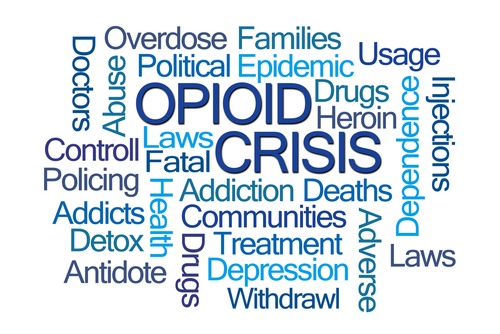
More Ohio residents died of opioid overdoses during a three month period of 2020 than at any other point in the last decade, according to a new analysis released by the Scientific Committee on Opioid Prevention and Education (SCOPE) initiated by Ohio Attorney General Dave Yost.
Throughout the last year’s second quarter, Ohio’s opioid deaths reached 11 per 100,000 people, a figure made more striking because it follows a 24 month turnaround that began in 2017. That turnaround has brought opioid death rates down to between six and eight deaths per 100,000 people. In fact, the new spike was fueled by an increase of deaths in approximately two-thirds of Ohio’s counties, although Scioto and Fayette were the hardest hit.
“Opioid overdoses might have taken a backseat in our minds last year because of COVID-19, but make no mistake: Ohioans are dying at a devastating rate because of opioid overdoses,” Yost said. “This is alarming data, and while COVID has rightly captured our attention, we cannot lose sight of the threat the opioid epidemic brings to all areas of Ohio.”
Indeed, the spike largely coincided with the spread of COVID-19 and growing lockdown orders throughout the country. Yet Dr. Julie Teater, the medical director of addiction medicine for the Ohio State Wexner Medical Center, notes that the trend was beginning even as early as January and February.
“That indicates, to me at least, that there were additional things going on,” Teater said. “One that can’t be ignored is the contribution of fentanyl in overdose deaths. In many cases now, heroin for example is very little heroin and a very large percentage fentanyl. It’s also in our non-opioid drug supply. People using those stimulants don’t have an opioid tolerance, so even a small amount of fentanyl can cause an overdose.”
Fentanyl was not the only thing contributing to the rise in cases. Teater noted the impact of COVID cannot be ignored – lockdowns made patients with substance abuse disorders less likely to seek help or to even leave their houses. That social isolation could threaten a spiral into greater substance abuse, yet admission numbers for treatment or emergency room visits declined.
“People saw substance abuse treatment as “voluntary,” something that could be deferred – when in reality it can be lifesaving,” Teater said.
Drug supply lines were also endangered, and that made people more likely to turn to suppliers or substances they were unfamiliar with to get help. In essence, all of this made for a lot of changes in a very short period of time, threatening people’s ability to cope.
Many have tried to turn this around. Yost recently joined a coalition of 48 attorneys general in writing the U.S. Food and Drug Administration (FDA), seeking details on the agency’s efforts to combat the crisis. The FDA was given new authorities to do so by Congress in 2018, as part of the Substance Use-Disorder Prevention that Promotes Opioid Recovery and Treatment for Patients and Communities (SUPPORT) Act. Some of the efforts urged with those powers were new guidelines for opioid prescriptions, safer opioid packaging and disposal features, along with research and deployment of new regulations for non-addictive alternatives to opioids.
“I am committed to using all the tools available to combat opioid addictions and save lives,” Yost said.
In Ohio, Teater said efforts over the last 15 years have included the shutdown of pill mills and crackdowns on opioid prescribing, both of which impacted the number of people exposed to opioids in the first place.
“It’s only one part of a strategy to help those who have already been exposed and have already developed opioid abuse disorder,” Teater said. “Part of what we’ve seen is people moving from pills and prescribed medications to elicit substances like heroin and fentanyl that have no regulation. We need to work in tandem on those that have already fallen in, because for many, the cat is already out of the bag.”
Recently, Teater and her colleagues at Wexner have tried to adjust their own efforts to a COVID-19 world. While putting up new precautions at their treatment center to make physical distancing easier and safer for patients, and making virtual options more prevalent, they have also begun to provide the general public with NARCAN, a nasal spray formulation of naloxone that is used to treat opioid overdoses. Any patient can leave a hospital with a NARCAN kit now, but they also have taken those kits into communities.
Throughout 2020, they joined other community stakeholders as part of Project DAWN, a network of Ohio-based drug overdose education and naloxone distribution programs, to distribute NARCAN community-wide through so-called NARCAN pop-ups. These outreach efforts took place at food banks, grocery stores, gas stations and other areas well-populated even during the COVID-19 pandemic. Partners in the effort included organizations like the Columbus Public Health Department and the Columbus Fire Department Rapid Response Emergency Addiction Crisis Team division.
“We spent most of the summer, continuing through to now, going to different locations and advertising on social media that we were giving out NARCAN kits to those who want and need them,” Teater said. “That was a really interesting experience. We were seeing people who weren’t seeking our assistance, seeing people in their natural habitats. It really was a group effort.”
Thousands of kits were handed out and experts had the opportunity to educate the public on the opioid crisis. So while cases have spiked, experts hope the evolution of tactics to meet them will have a positive impact.

